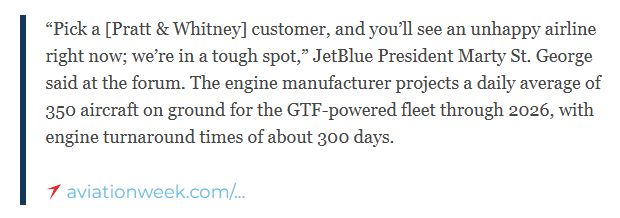- in European Union
- with readers working within the Banking & Credit industries
- within Law Department Performance and Environment topic(s)
According to the FAA, air travel set new records in the United States during the Thanksgiving holiday, with more than 232,000 flights carrying more than 12 million passengers from November 24 to November 28. That's an increase of more than 400,000 passengers from 2023 results.
But is the growth sustainable?
The answer revolves around the supply chain's ability to keep pumping out new airplanes and producing enough parts and skilled labor to keep those planes in the air. I think the short answer is "no." The quote below from JetBlue President Marty St. George is a common refrain in aviation circles: not enough aircraft are being delivered, and maintenance turnaround times are too long, which reduces global effective airline capacity.
Suppliers in the air frame and turbine engine supply chains are having difficulty with labor, raw materials, and special process providers (heat treatment, chemical coatings, etc.), which are all contributing to limiting overall industry output. Exacerbating the situation are imbalances in various sectors of the supply chain (e.g., powdered metal component production for Pratt & Whitney, interior components at multiple air frame manufacturers) that cause inventory levels to become out of sync and lead to conflicting demand signals for different types of suppliers.
All of this instability and inconsistent demand within the industry is going to continue for the foreseeable future, and participants with robust demand signal forecasting and nimble manufacturing processes will be best positioned to weather the storm.
The content of this article is intended to provide a general guide to the subject matter. Specialist advice should be sought about your specific circumstances.



